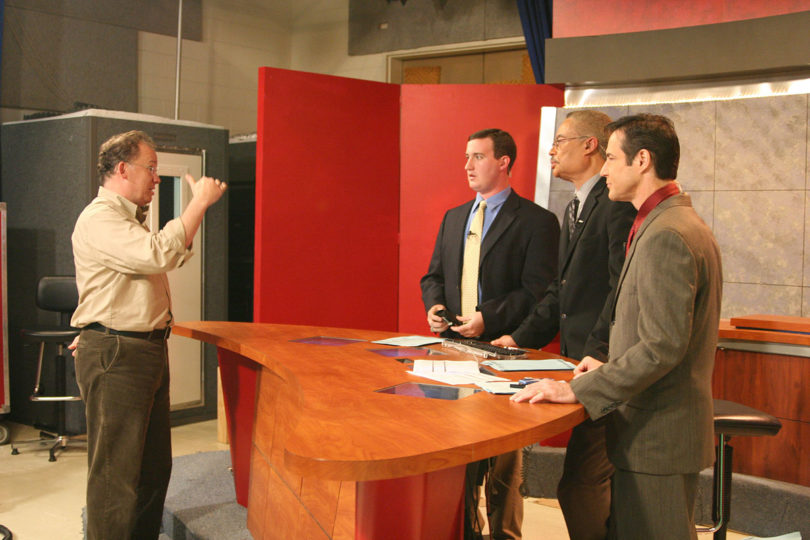A milestone was reached Oct. 27 when WNEG-TV broadcast its first full newscast from the Grady College of Journalism and Mass Communication.
The production was the culmination of 18 months of effort, hard work and donated time by the faculty and staff of the Grady College and WNEG. The 6 p.m. broadcast by news anchor Ray Metoyer, sports anchor Cody Chaffins and meteorologist Eric Elliott signaled a new beginning for the station and the college.
“We were delighted with this first newscast from Athens,” said Ann Hollifield, head of Grady’s department of telecommunications. “Live television requires split-second coordination between numerous people, all done in real time in front of the audience. . . . The WNEG staff was working in a new facility with new equipment. That’s not easy, but it went very well.”
University officials announced an agreement to acquire Toccoa-based WNEG from Media General Inc. last year. The station’s license was transferred to UGA on Oct. 15, 2008, after approval by the Federal Communications Commission. The purchase and start-up of the commercial station was funded through a $5 million grant by the UGA Research Foundation.
TV staff merge into college
Since that time, more than 30 WNEG reporters, sales representatives and staffers have been merged into the college, a new TV facility was designed and constructed on the first floor of the Journalism Building, additional on-air talent was hired, legal and technical issues were addressed, a four-month construction delay was dealt with, and programming and news content decisions were made.
Spearheading many of those decisions have been lecturer Michael Castengera, associate professor David Hazinski and lecturer Steve Smith, all faculty in telecommunications.
Castengera, designated project manager of the new endeavor, was happy with the first show.
“The first broadcast in a new facility is the scariest one. Everything went smoothly,” he said. “The whole process will continue to evolve over time.”
After a dress rehearsal by the news and production teams Oct. 24, the Oct. 27 evening newscast went well.
“The main thing we wanted to accomplish was just to put on a clean show,” said news director Jeff Dantre, who has been in the news business for 31 years. “I don’t see us trying to have a lot of bells and whistles. We have to get our talent and crew accustomed to the new facility, new equipment and new surroundings.”
With the first newscast, the WNEG news department is now in-house and will broadcast from an existing studio at Grady. The rest of the station’s operations will move in stages, with a goal of having the new studio up and running by mid-to-late December.
“We’re not abandoning Toccoa. We’re just organizing here instead of there,” said Hazinski. “We intend to keep a news and sales presence there.”
The physical facility is less important with the new WNEG concept, according to Hazinski.
“The whole idea behind the technology and how we’re designing the station is that you don’t need a TV station to contribute to an information system any more,” he said. “When I worked at NBC, we had elaborate, expensive bureaus. Now you can do the same thing out of a laptop and a wireless Internet connection. We hope to use those kinds of technological advances and economies to basically spend the money to get out further and get into stories deeper.”
While Grady professors are trying to build an economical, efficient and smart model, they’re not trying to copy what the industry does.
Building a new model
“We’re trying to find a less expensive and more effective way to deliver the same thing. So it’s built into the DNA of the station that it will try to do things and experiment on a low-cost basis,” Hazinski said. “There are no models—we need to build a new model, and it’s got to be one that’s very efficient and serves the audience better.”
A new model is needed because the economics of media have changed radically in the last five years and stations can’t generate as much advertising and profit as they once did.
“We’ve also seen a sea of information sources open up to people—all of which are competition for us,” Hazinski said. “So unless we do a better job, they won’t pay attention to us. We have to change how we teach and how we interrelate with the industry.
“We have an opportunity to serve Athens and Northeast Georgia better,” he added. “We have an opportunity to extend the value of the university into the community. And we have the opportunity to try and redefine local media.”
New opportunities for students
The station’s integration promises even more opportunities.
“It will provide our students with new prospects for professional education and our faculty with new opportunities for research and outreach,” said Hollifield. “We are very proud to be able to offer Athens its first local commercial television newscast, and we look forward to serving all of the communities of Northeast Georgia.”
“The Grady College has aired flawlessly its first broadcast news program over a commercial license,” said Cully Clark, dean of Grady College. “A new era has begun.”
That new era was summed up best by news director Jeff Dantre who said, “The first newscast is significant because this is where we were intended to be from the time the station was purchased—we’re finally home.”
WNEG airs nightly newscasts at 6, 7, 10 and 11 p.m. on Charter Cable Channel 6 locally.
Channels vary throughout the 16-county coverage area. See www.wnegtv.com for channel listing by county.







